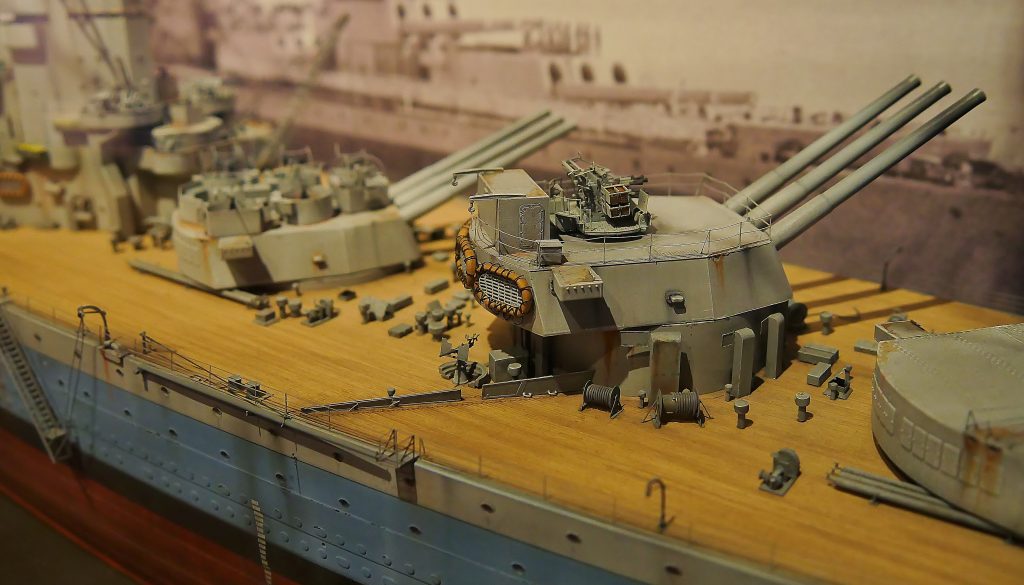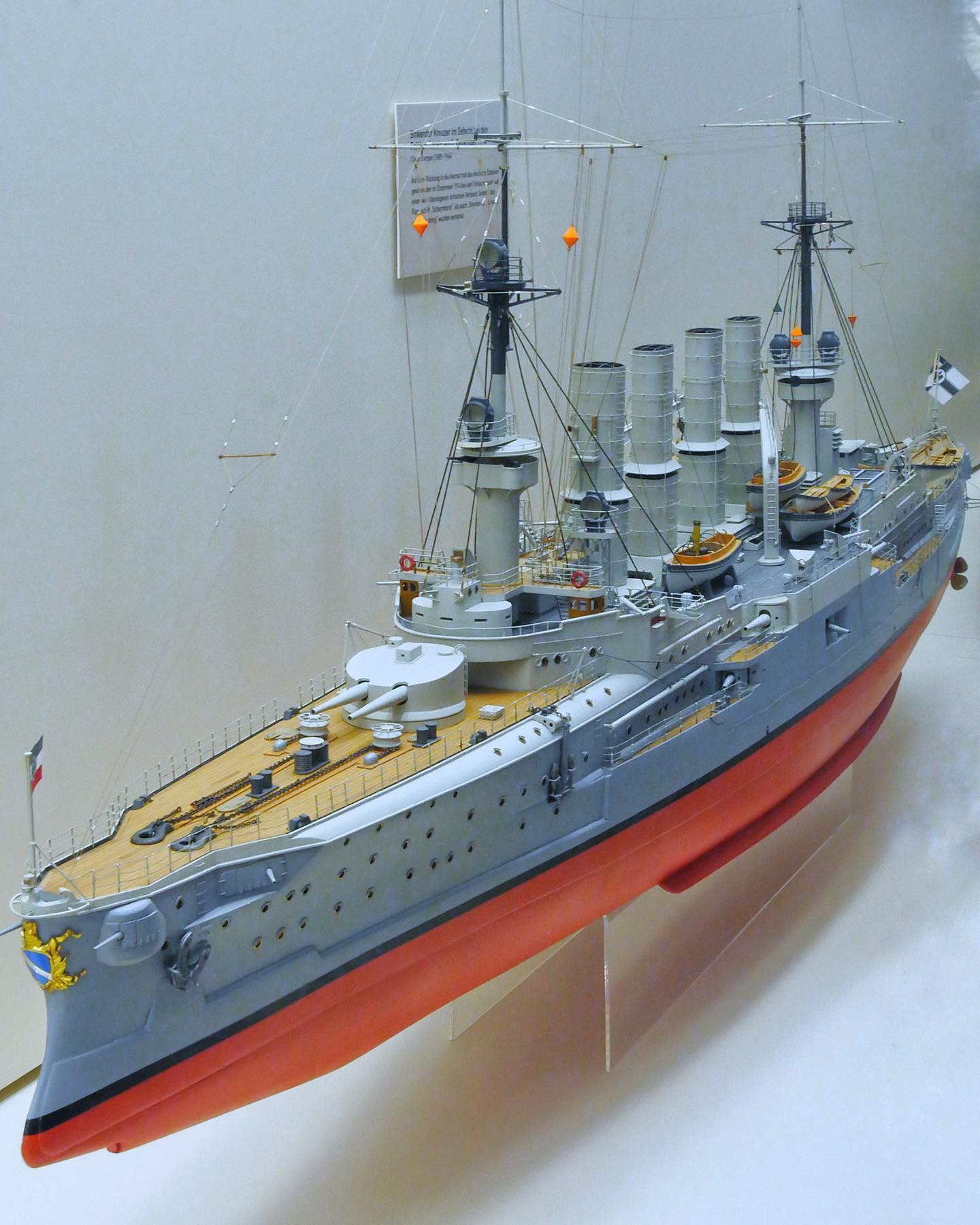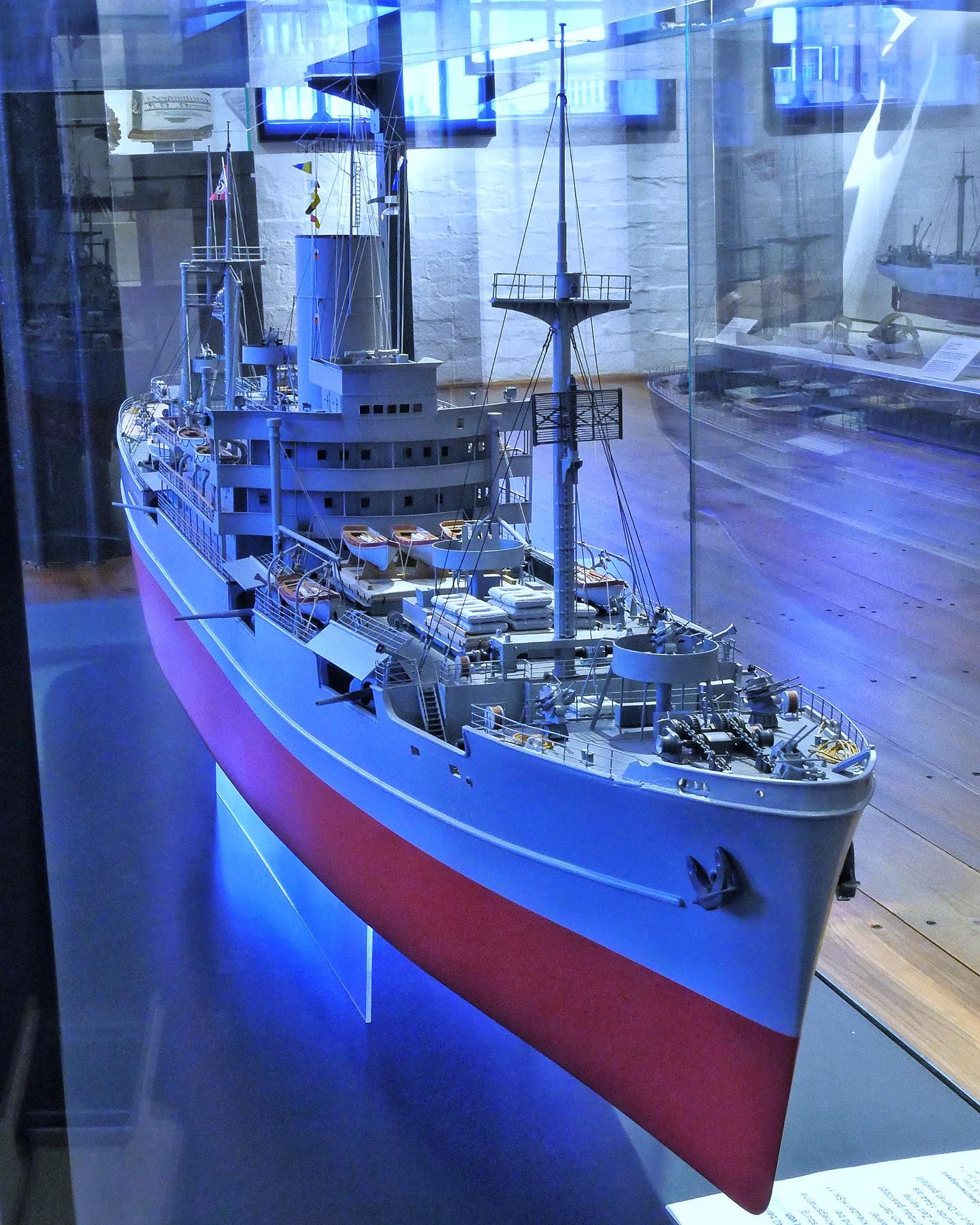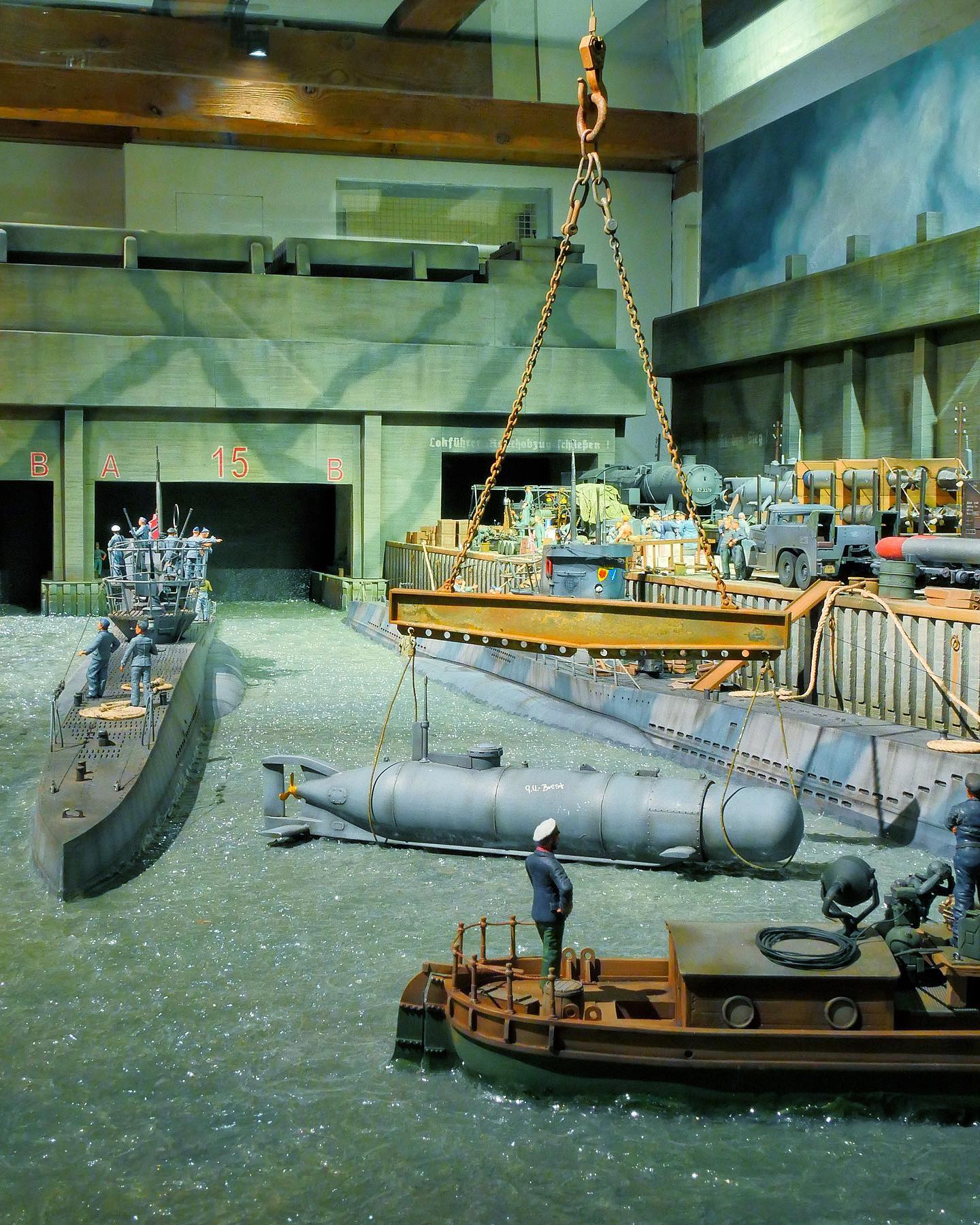Guide to deck 5: War and Peace

50 – Introduction: Deck 5, War and Peace
Audioguide:
Exhibition deck 5 deals with the development of the world’s navies in the 19th and 20th centuries.
The industrial revolution of the 19th century also affected the construction of warships. No longer sails, but steam engines, then turbines and motors powered ships whose hulls were no longer made of wood, but of iron or steel. At the same time, the armouring of ships‘ hulls competed eerily with the development of shells, gun barrels and finally long-range guided weapons. The introduction of the mine and torpedo as well as the appearance of a new, sinister weapon, the submarine, created further potential dangers. The strategy and tactics of naval warfare adapted to the respective advances in weapons technology.
As a status symbol of national power, capital ships demonstrated the technical and industrial maturity of a state for many decades. Naval power was measured above all by the number of capital ships. Quantitative and qualitative arms races were the result. Submarines and aircraft destroyed the nimbus of the capital ship during the Second World War.
During and above all after the end of the Cold War, another drastic change in strategy became apparent. Submarine fleets equipped with nuclear weapons and aircraft carriers dominated the thinking and actions of the naval powers. Today, changed threat scenarios such as international terrorism demand new solutions, i.e. a new naval armament.
51 – The Bundesflotte
Audioguide:
On 14 June 1848, the Frankfurt National Assembly decided to establish a German Imperial Fleet. The Danish blockade of the German coasts in the dispute over the duchies of Schleswig and Holstein is considered the immediate cause.
Last but not least, this German Imperial Fleet was the result of two revolutions – one social and one technical. The decision to found the fleet was based on a political, revolutionary movement that resulted in a German parliament. In terms of military technology, the plans of the National Assembly envisaged the construction of a steamship fleet. This was a very modern concept at the time and entailed fundamental innovations in naval organisation.
In the summer of 1849, the attempt to establish a democratic nation state in Germany failed. This failure also meant the end of the German Federal Fleet.
The American Civil War of 1861 to 1865 saw the emergence of modern navies under conditions of military conflict. The so-called „ironclads“, armoured ships like the USS „Monitor“ of the Northern States and the CSS „Virginia“ of the Confederate States, the first spar torpedo boats like the CSS „David“ or the first submarine like the CSS „Hunley“ – you can see the latter in the submarine section – changed the technical, tactical and strategic conditions of naval warfare. Nothing was the same as in the days of Admiral Horatio Nelson’s sailing fleets.



52 – The Torpedo vs. Armour
Audioguide:
Since the 1830s, the arms race between France and England intensified. The centuries-old rivalry between the two nations led to new military and strategic developments.
In 1859, the French ironclad „Gloire“ was the first ocean-going steamship protected with iron plates. England responded in 1861 with HMS „Warrior“, the most modern warship of its time because it was built entirely of iron.
The layout of the main artillery of the warships changed from the classic broadside battery to revolving turrets. The advantage of this was that fewer guns could be used, because moving targets could be tracked with the new armament.
Ship designers were looking for the best possible combination of propulsion, armament and armour in the cheapest possible ship. The result was a race between armour and armament.
In 1866, the British engineer Robert Whitehead developed the self-propelled torpedo. The self-propelled underwater projectile could hardly be located and detonated on direct contact with the target. The new weapon necessitated a fundamental redistribution of armour throughout a ship’s hull.
In the late 19th century, a new strategy developed in the French navy. The defeat in the Franco-Prussian War of 1870/71 had severely weakened France. Great Britain was superior as a naval power in technical and industrial terms. The construction of large armoured ship fleets proved impossible for France to finance.
The French navy invested in modern weapons: In the event of war, torpedo boats were to attack English ships, and maritime trade was to be brought to a standstill with fast merchant destroyers. This strategy, called „Jeune École“ – meaning „Young School“ – paved the way for commercial warfare with submarines in the age of the two world wars.

53 – The Transition between the 19th and the 20th Century
Audioguide:
For more than 30 years, technological revolutions influenced the world’s navies. In the 1890s, this process seemed to have come to a temporary end in terms of the development of ship types: Steam-powered, steel-armoured ships of the line had turrets fore and aft, each with two heavy guns. Smaller, lighter-armed fast cruisers formed reconnaissance units for the fleet, torpedo boats threatened the enemy’s large ships.
„Germany’s future lies on the water“ proclaimed Kaiser Wilhelm II. At great expense, the last German Emperor and King of Prussia pushed ahead with the rearmament of the Imperial Navy.
The monarch pursued the goal of establishing the industrially emerging empire as a great naval power. Under the budgetary constraints of the Reichstag, the Fleet Laws prepared by Admiral Alfred von Tirpitz legitimised the rapid build-up of the German navy from 1898 onwards. Tirpitz accompanied the Kaiser’s plans with an unprecedented propaganda campaign.
In England, Admiral Sir John Fisher modernised the British naval force from 1904. Fast capital ships were to protect the Empire’s lines of communication against French or Russian privateers and also keep the German merchant fleet in check. Flotillas of nimble torpedo boats as well as submarines were intended for the defence of the domestic sea areas. Fisher focused on quality.
Worldwide, the expansion of the fleets grew. The first major battle between squadrons of armoured ships took place as early as 1905, when the Japanese and Russian fleets demonstrated the destructive power of heavy guns in the naval battle of Tsushima.



54 – The Dreradnought and World War I
Audioguide:
One result of the modernisation of the British Navy begun by Admiral Sir John Fisher was the capital ship „Dreadnought“, launched in 1906. The huge warship had five turrets with guns of 30.5 cm calibre. The 28-centimetre thick plates of the side armour protected the vital parts of the colossus amidships at waterline level. Watertight transverse bulkheads divided the 23,000 hp and 21 knot ship into 18 compartments. The engine plant of the „Dreadnought“ no longer consisted of piston steam engines, but of turbines. With capital ships of this type, England, as the naval and colonial power, seemed to be able to put a stop to any potential rival.
Until 1914, following the Anglo-French arms race of the 19th century, there was a competition of building programmes between England and Germany. Gradually, however, all the major powers began to build dreadnoughts. Dreadnoughts meant naval power.
The First World War began in 1914 and ended in 1918. From the beginning of the war, England and France blockaded the German North Sea coast. The imperial battle fleet proved unsuitable to break the long-distance blockade of the Entente. The naval warfare of the First World War was dominated on both sides by the so-called small-scale means of combat: U-boats, torpedo boats, minelayers and seaplanes. German submarines served as offensive weapons to stop British trade.
The expensive English and German „dreadnoughts“ clashed in the naval battle off the Skagerrak on 31 May 1916. Neither side was able to gain any military advantage from the battle. There was no further decisive battle between armoured ship units.







– Auxiliary cruisers


55 – The Submarine
Audioguide:
Until the first fully functional submersible, the „Seeteufel“, built by the Bavarian artillery officer Wilhelm Bauer in 1856, there were many studies, constructions, attempts and failures to advance submarine navigation. By 1900, however, the submarine was established in all the world’s major navies. Tiny submersibles that deployed their weapon unseen promised an advantage over more powerful nations, especially for smaller naval powers.
Older officers, still stuck in traditional battleship thinking, initially harboured doubts about the tactical and strategic effectiveness of submarines. However, the First World War removed all doubts about the striking power of undersea offensive weapons. On 22 September 1914, the German submarine „U 9“ sank three British armoured cruisers within 75 minutes.
In both the First and Second World Wars, Germany emerged as the vanguard of submarine warfare against Britain’s international maritime trade. The Royal Navy responded by introducing a convoy system: convoys of several escort ships provided protection for merchant ships. Improved technologies for locating and fighting submarines were also used.
Both world wars led to technological leaps in the development of submersibles. Within four decades, submersibles matured from relatively primitive boats to highly sensitive, silent operating and lethally effective machinery.
Even beyond the duration of the Cold War, this process continued. Today, submarines are both nuclear and fuel cell powered. As strategic missile carriers, they have state-of-the-art torpedoes and intercontinental ballistic missiles. As a weapon for dominance in the coastal forefield, the boats from the deep are indispensable.







Not on display:

56 – World War II
Audioguide:
When the National Socialists came to power, the arms restrictions on new ships imposed on the German Reich by the Treaty of Versailles were at first still cautiously undermined with regard to the naval power England. In 1935, a fleet agreement with Great Britain regulated the further construction of the new navy. From May 1938 onwards, Adolf Hitler took Britain’s opposition into account in future steps of his expansion and power policy. The so-called „Z-Plan“, a massive rearmament programme, decided on the armament priorities: Hitler wanted battleships – as a political pawn and visible threat potential against the great powers. As in 1914, this strategy was doomed to failure. London could neither be pushed nor forced into a coalition nor into far-reaching political concessions by a renewed German fleet build-up. On 28 April 1939, the German Reich terminated the naval treaty with England. After Hitler’s invasion of Poland, Britain declared war on Nazi Germany.
The largest and most powerful battleship of the German navy was the „Bismarck“, launched in 1939. The 251-metre-long and 36-metre-wide steel giant was intended to operate against the British sea lines in the event of an armed conflict. The „Bismarck“ sank on 27 May 1941 during her first operation against the British fleet. Her sinking meant the end of strategic operations by German battleships in the Atlantic, as such units no longer stood a chance against Britain’s combined sea and air power.
The Japanese attack on the American Pacific base at Pearl Habor in December 1941 turned the European conflict into a world war. The surprise attack by fighter pilots from a Japanese aircraft carrier unit inflicted considerable losses on the US fleet. Nevertheless, Japan’s naval strategy remained geared towards a decisive battle with large battle fleets.
The „Yamato“, weighing over 62,000 tons and equipped with nine 45 cm guns, was the largest battleship ever built. On 7 April 1945, American aircraft sank the Japanese super battleship in the East China Sea. If any proof was needed that battleships had no chance against aircraft and aircraft carriers, it was provided by this tragedy.




In other decks:

57 – Post War Times
Audioguide:
After the end of the Second World War, the alliance of convenience that united the victorious powers against Nazi Germany disintegrated.
For four decades, the fleets of the USA and the Soviet Union faced each other in a Cold War scenario between two military alliances.
The USA invested in the expansion of its mobile carrier battle groups. At the same time, they modernised their shipbuilding, aircraft and electronic warfare. The Soviet Union strengthened its submarine fleet in particular and tried to keep up with the NATO countries in electronic warfare.
With the collapse of the Warsaw Pact at the beginning of the 1990s, the Cold War came to a non-violent end. The quantitative arms race between the two superpowers and their power blocs was over.
The armament priorities shifted internationally in the direction of a qualitative expansion of shipbuilding and weapon systems, although today there is no interstate or alliance threat scenario.
For modern surface warships, the aim is to remain hidden from detection by enemy radar or infrared equipment for as long as possible. Since the 1980s, so-called stealth technologies have been used. In stealth ships, clear contours hardly exist. The classic ship superstructures are limited to smooth, sloping surfaces and cube-like structures. The signatures of a ship, such as warm exhaust plumes, are reduced to a minimum.
57.2 – The Cold War
Audioguide:
After the end of the Second World War, the alliance of convenience that united the victorious powers against Nazi Germany disintegrated.
For four decades, the fleets of the USA and the Soviet Union now faced each other in a Cold War scenario between two military alliances.
The USA invested in the expansion of its mobile carrier battle groups. At the same time, they modernised their shipbuilding, aircraft and electronic warfare. The Soviet Union strengthened its submarine fleet in particular and tried to keep up with the NATO countries in electronic warfare.
With the collapse of the Warsaw Pact at the beginning of the 1990s, the Cold War came to a non-violent end. The quantitative arms race between the two superpowers and their power blocs was over.


58 – Naval Aviation
Audioguide:
„Naval aviation“ is the term used for manned military aircraft under the command of naval forces. In this section we are devoted to the military use of powered aircraft over sea since their development in 1903, for no sooner could man fly than he used the aircraft as a weapon and attempted to use this weapon from ships to increase the range of the tiny aircraft over the vast oceans. The tentative beginning was during the First World War, and during the two decades that followed, more and more aircraft carriers joined the fleets, ships whose main weapon was the wheeled aircraft. During the Second World War, the aircraft carrier system matured to full effectiveness in those naval powers such as the USA, Great Britain and Japan that operated over vast sea areas. Aircraft carriers became the main fighting ships of the fleet, as their flying formations could inflict damage on any ship and strike suddenly and anywhere from the vastness of the oceans.
The construction of aircraft carriers followed military operational requirements and tactical preferences. While the United States used the „carrier“ as the core of an independently operating unit („task group“) in World War II, it was used in Great Britain and also in Japan to support the battle fleet. Different types of aircraft fulfilled requirements such as reconnaissance, attack and fighter protection. Naval aviators will continue to play a crucial role in gaining and defending naval power. Today, new naval powers such as China and India are pushing to own aircraft carriers.

59 – Stealth
Audioguide:
After the end of the arms race between the power blocs in the West and East during the Cold War, armament priorities shifted towards a qualitative expansion of shipbuilding and weapon systems.
For modern surface warships, the aim is to remain hidden from detection by enemy radar or infrared equipment for as long as possible. Since the 1980s, so-called stealth technologies have been used. The classic ship superstructures are limited to smooth, sloping surfaces and cuboid-like structures. The heat signature of a ship, such as exhaust plumes, is reduced to a minimum.
Stealth technology is expensive, also and especially the leading maritime powers are increasingly in financial straits since the economic crisis of 2008. It is therefore not surprising that ambitious defence programmes such as the American „Zumwalt“ class ships have been cut from a planned 30 units at a price of several billion dollars per ship to just three.
The renewed flare-up of a Cold War between NATO and Russia in the context of the Ukraine and Syria crises is therefore an additional burden for everyone.

